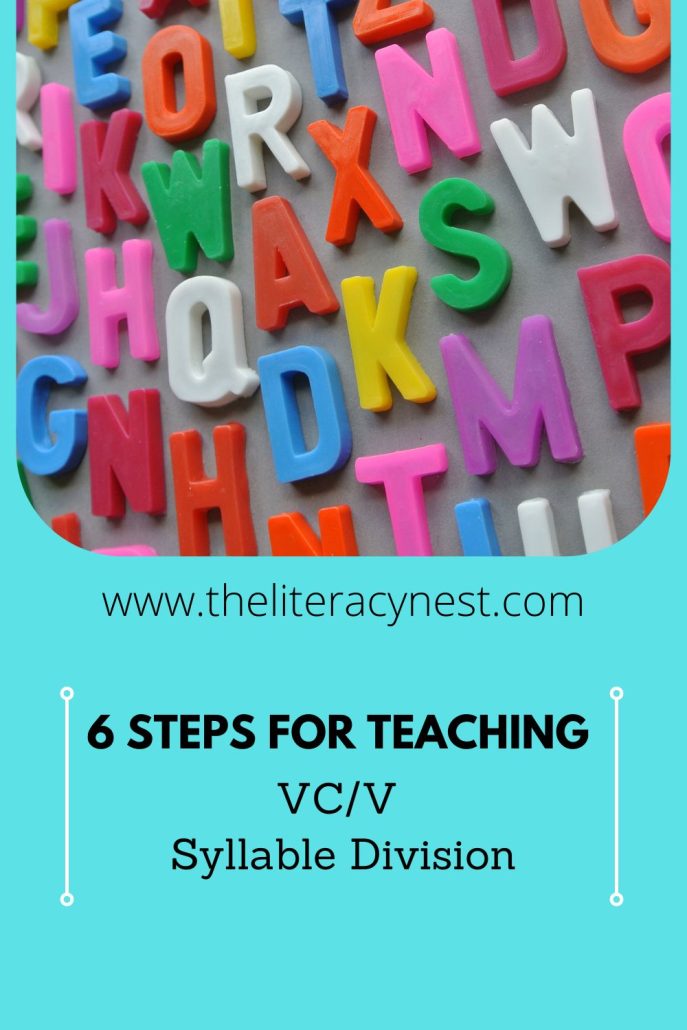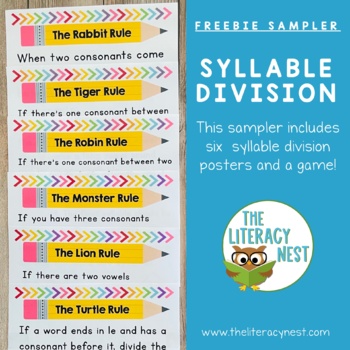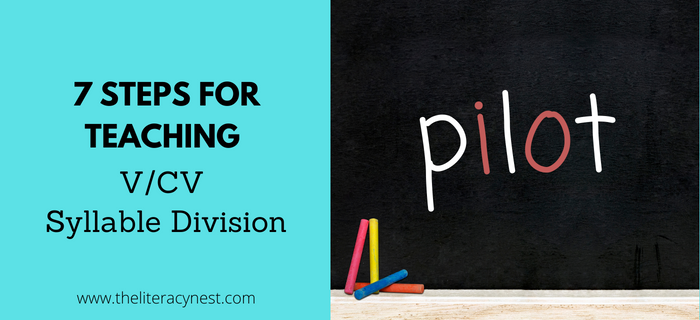6 Steps for VC/V Syllable Division
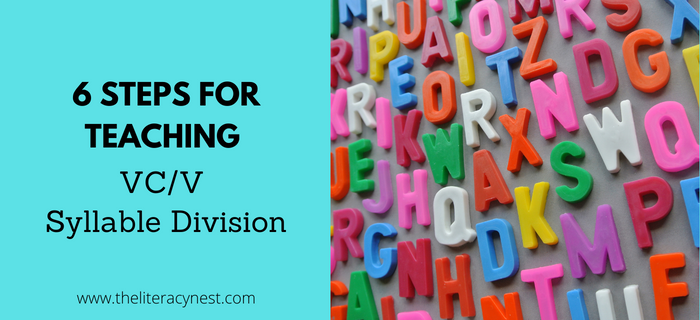
This post about VC/V syllable division is the next in our series on syllable division. The easiest and most common type of syllable division is the division between consonants. The next most common is V/CV syllable division, also discussed previously.
Check out the previous posts in this series:
Syllable division rules are helpful to students in several different ways. These rules provide students with a framework through which to decode multisyllabic words. Mastering syllable division helps students to access a much wider variety of printed material.
When to Teach VC/V Syllable Division
VC/V syllable division is a pattern I typically teach after students have had extensive practice with V/CV division. I typically wait until students are familiar with the first 5 syllable types (Closed, Open (at least in single syllable words), Vowel Team, R-controlled, and Vowel-consonant-e) before introducing this type of syllable division. I like for students to have a thorough working knowledge of vowel teams.
When students have just one consonant between vowels, it is necessary for students to decide whether to divide the word before the consonant making an open syllable in the beginning or after the consonant making a closed syllable. Because the most common option is dividing after the vowel making an open syllable, I teach this first and provide students with extensive practice in isolation before teaching VC/V division.
How to Teach VC/V Syllable Division
I have found the same technique we used for division between consonants to be very successful in introducing this new concept and for scaffolding for a student if they are struggling with dividing a word later.
Step 1: Write the word.
Write a word in large letters on a chalkboard or whiteboard. If teaching remotely, it is helpful to stretch the word so the spacing between letters is loose on the slide or app you are using.
Step 2: Underline the vowels.
Ask your student to underline the vowels in the multisyllabic word.
Step 3: Touch the vowels.
Ask your student to place their left hand on the first vowel and their right hand on the second vowel. It is helpful to adjust your instructions here to the individual child. For children that struggle with oral language, modeling or providing hand-over-hand support to complete this step may be helpful.
Step 4: Verbalize what is between the vowels.
Ask your student to look in between their fingers and verbalize what they see. At this point, it would be a single consonant.
Step 5: Explain the two choices.
Explain to the student that when there is just 1 consonant, they have two choices. They have already learned how to divide after the first vowel and today they are going to learn the less common division after the consonant. This creates a closed syllable in the first syllable making the vowel sound short.
Step 6: Identify the syllable types.
Take the further step of identifying each of the syllable types and marking the vowel sound in the first syllable with a breve.
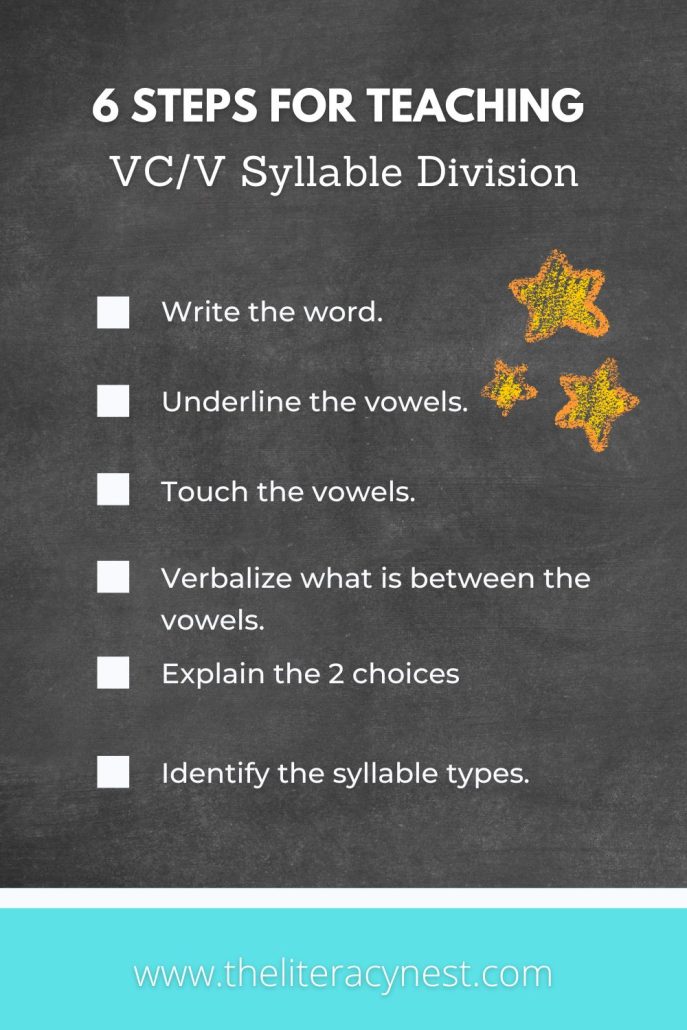
It is important to provide students with extensive practice and to become comfortable with VC/V syllable division in isolation before providing mixed practice. Some examples of VC/V words include robin, camel, never, cabin, and finish.
More Practice
After introducing this new syllable division pattern, it is important for students to have the process to build automaticity through practice. Following the steps of underlining and marking syllable division is one way to reinforce this. Using linking cubes and cutting word cards are also multisensory ways to practice. Small whiteboards or sylla-boards are excellent for practicing encoding this pattern. It is helpful to mark short vowels with a breve and long vowels with a macron as well as indicating syllable type. Beginning with more hands-on approaches and gradually moving to less intensive methods as the process becomes more natural is a useful goal.
While initially, I would use only VC/V words while introducing the skill, you will need to combine this with V/CV words and give students extensive practice at being flexible and trying multiple options. As students move into more advanced concepts, it becomes increasingly important for students to Eventually, you will want to mix VC/CV, VCC/CV, VC/CCV, and V/CV words in word lists and sentences. Don’t neglect the review of foundational skills such as syllable types. Those skills are part of the process of solving these longer words efficiently.
Use Games to Make it Fun!
Almost any game can be used to practice this skill, especially for reading. The only limit is your imagination.
A simple card game that is a particular hit with younger students involves word cards and several “bad cards”. This can be thematic or working with a student’s particular interests. Players take turns drawing cards and reading words. You can set a specific number of cards like 1-3 or unlimited. If the player chooses to end their turn without getting a “bad card” those cards are locked in and safe. If a player pushes their luck and gets a “bad card” they must return all the cards from that turn to the deck. Easy to make variations of and fast to play, it provides lots of reading practice.
Incorporate gross motor movement by having students be the pawns on a life-size sidewalk chalk game board. Students need to break words correctly or even spell them to roll the dice and move forward. Students could build words using an assortment of closed syllables and ending syllables for a more open-ended game-like activity.
Sorting words by the vowel sound in the first syllable can also prove a valuable practice. Repurposed turn-taking games such as Crocodile Dentist or Pop the Pig are well suited to the gamification of any reading list. Roll to 100, memory match, and go fish are low preparation print and go games.
Are you looking for resources to teach syllables?
I have multiple resources available for teaching about syllables and syllable division available in my TpT store! I even have an incredible, multi-sensory, FREE resource you can grab, too!
And you can save time searching for words with VC/V syllable division, check out Word List Builder! With Word List Builder you can build your folder of words and create templates!
Coming soon…
I’ll be adding a blog post to teach C+LE syllable division soon!
